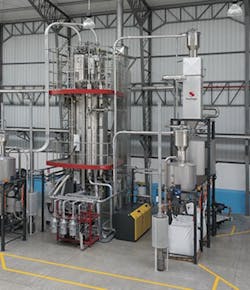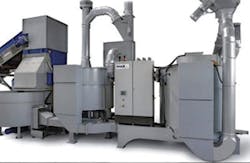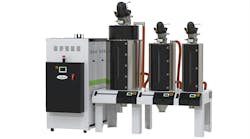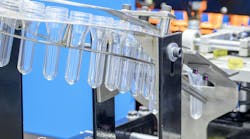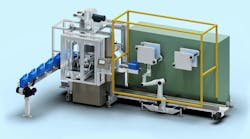In plastics recycling, capturing energy to reuse in another part of the process hasn't gained a huge following in the U.S. yet, but options are available to recyclers looking for another way to improve finances — and make a stronger contribution environmentally.
American Starlinger-Sahm
American Starlinger-Sahm offers an energy recovery unit as an option on its viscoStar solid-state polycondensation (SSP) reactor, which is used to decontaminate PET pellets or flakes and increase the material's intrinsic viscosity. The viscoStar SSP reactor is used in-line after a pelletizing extruder.
When PET is removed from the reactor, it retains heat, said Alan DiUmberto, sales manager for the company. The resin has a temperature of more than 400 degrees Fahrenheit, so it would melt poly-lined boxes or flexible intermediate bulk containers if it came into direct contact with them.
"So, we can bleed off the energy of this material beforehand using heat exchangers," DiUmberto said. "Since earlier steps of the process call for increasing the temperature, we then place the exiting pellets in an exothermic state by removing the energy inside of the pellets, and transfer it back to an earlier stage in the process, which calls for an increase of pellet temperature. This way we reduce the overall energy requirements for the process."
The captured heat is diverted back to an extruder or dryer, resulting in energy savings of as much as 10 percent.
The biggest advantage to this feature, DiUmberto said, is the reduction of operational costs. "We sell most of our products into the recycling market, which is constantly under pricing pressure. This way we can increase a company's competitiveness by reducing their overhead."
For Starlinger, the biggest challenge to marketing the energy recovery unit in the U.S. market is low energy costs, compared to the rest of the world. "Processors are not convinced that energy recovery is mandatory or needed," DiUmberto said.
However, there are energy-conscious recyclers interested in the option, mainly on the West Coast. "We should become more efficient in the way we practice energy consumption, without having to rely on legislation to make it happen," he said.
MAS
Double-rotor disc (DRD) waterless cleaning and drying systems from MAS, Pucking, Austria, have integrated energy-recovery features. The systems, which are suitable for processing waste plastic film, flakes and fibers, dry and clean in a single step, combining a cleaning centrifuge with thermomechanical drying. They remove dust, sand, soil and moisture, and can process about 1,100 to 3,530 pounds per hour, depending on the model. DRD systems, which can be used by themselves or in conjunction with wet-cleaning equipment, use a heat exchanger to recover the energy of the exhaust air. The recovered energy is used to heat the air that enters the DRD system, said Hartmut Bendfeldt, president of eFactor3, which represents MAS in the U.S. If the DRD is used in a facility that also pelletizes the cleaned plastic, a heat exchanger can be used to recover energy from the water used in the pelletizing equipment. That heat also is used to heat the air entering the DRD.
The energy-recovery features provide both lower cost of operations and energy savings, Bendfeldt said. In addition, the DRD systems eliminate expenses associated with waste-water treatment and disposal, he said.
Allan Gerlat, correspondent
For more information
American Starlinger-Sahm Inc.,Fountain Inn, S.C., 864-297-1900, www.starlingersahm.com
eFactor3,Pineville, N.C., 704-944-3232, www.efactor3.com
